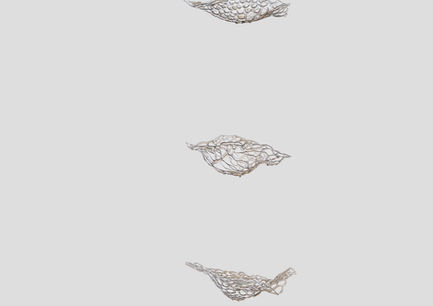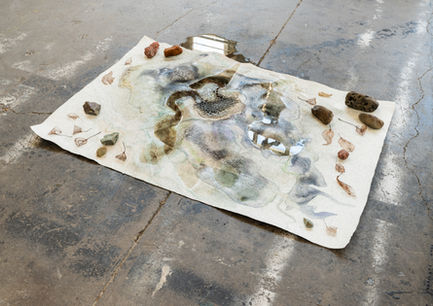MEMORY LAKE
2024 - 2025
Cast glass; water from Balch Creek, the Willamette River, the Columbia River, and rainwater; Serviceberry; Wild rose; White yarrow; Goldenrod; Tansy; Coreopsis; Dogbane; Cedar; Ponderosa pine; Douglas Fir; Horse chestnut; Oak gall; Walnut; Alder; Elk bone; Oregon grape; Lupine; Shale; tin can, handmade cotton paper, glass vials.
Dimensions variable
This site-specific installation was part of "Terrain,” a residency and exhibition in Portland, Oregon from 2024-2025. Artists were commissioned to make work responding to the site's unique history.
The exhibit took place in Building 5, which is now in an industrial area but was once Guild's Lake, a 250-acre riparian marsh. Fed by seasonal rainwater and the Willamette River, Guild Lake had a pulse, growing larger in winter rains, smaller in summer’s heat. During dry spells in the summer, it was marshy, offering critical habitat for birds and other wildlife. During the winter, it dilated to a deeper lake.
In 1905, to prepare for the Lewis and Clark Exposition, the lake was dammed and excavated it so it would look less marshy, more like a "proper" lake. After the Exposition ended, the lake returned to its original marshy state and fell out of favor with those in power. Later in 1905, Guild’s Lake was acquired by a developer and filled in for industrial use, using giant mining hoses to sluice dirt from nearby hillsides.
By 1913, a fifty-acre industrial center existed on what was once a lake. The first factory to be built in what is now Building 5 was a tin can factory.
In Memory Lake, pigments and waters foraged from the former lake's watershed drip from above like rain, making their way drop by drop through a series of glass forms that resemble cells, clouds, or constellations. The glass forms are modeled after lace that my grandmothers and her sisters made from hand. This lace was made around the same time the lake was disappearing.
The pigment and water drip through these layers of memory and land on a map of the former lake, refilling it drop by drop.
The tin can from which the water drips is a gesture towards closing the circle — that which removed the lake now helps it return.
The pigments and waters of a place offer a direct line to a place’s memory. In addition to the sculpture and the painting, the installation included a spectrum of glass vials. Each vial contains a pigment made from a plant or an animal that would have grown or wandered along the banks of the lake that once lived here.
While working on this piece, I dreamt
often and vividly of daylighting the creek that fed Guild's Lake, Balch Creek. I saw the creek touched by sunlight and rain, galloping through fern-lined banks to reach the floodplain. I saw the lake pulse like a slow heart. Each time I dreamt this dream, I felt an asphalt-heavy weight lifted from my chest. Relief. I tried to create that feeling here.





























